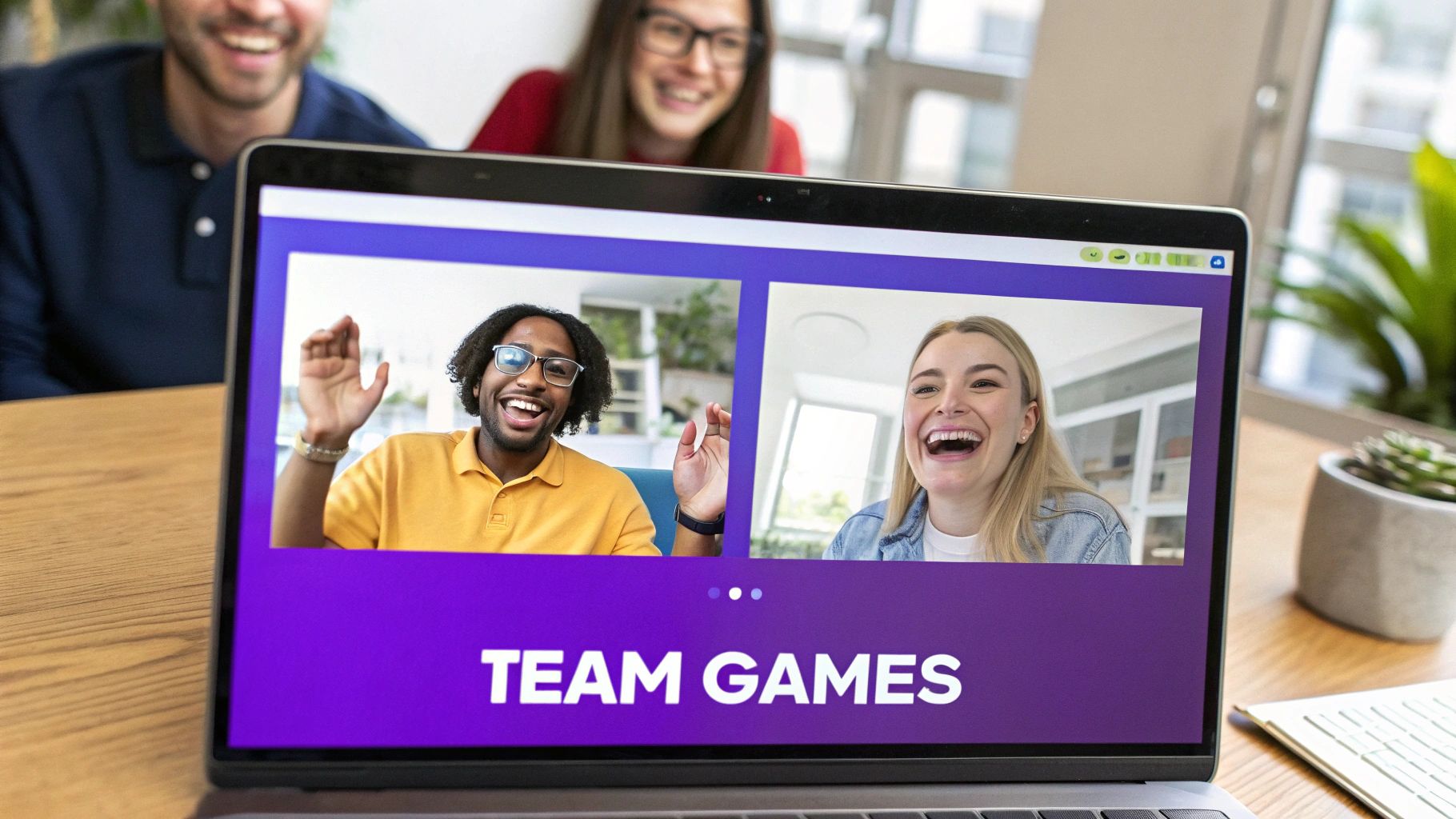The shift to remote work has transformed how we collaborate, but it's also created a new challenge: keeping teams genuinely connected and engaged. The spontaneous conversations that once built camaraderie in the office are gone, often replaced by a cycle of scheduled, agenda-driven meetings. This can lead to feelings of isolation and a decline in morale, ultimately impacting creativity and productivity. To combat this, companies must be intentional about fostering a vibrant virtual culture.
But what does it actually mean to be engaged at work? To fully appreciate the impact of virtual team activities, it helps to understand the core concept of What Is Employee Engagement and how it drives performance. This isn't just about fun and games; it's about building a foundation of trust and psychological safety that allows innovation to flourish.
This guide moves beyond generic advice to provide a curated list of impactful virtual employee engagement activities. We'll explore nine specific, actionable ideas designed to build trust, spark joy, and create a truly cohesive remote workforce. Each activity includes practical implementation steps you can use immediately. We'll also highlight how innovative tools like Bulby can supercharge your team's creative sessions, turning engagement into a driver of real results.
1. Virtual Coffee Chats and Water Cooler Breaks
One of the most effective virtual employee engagement activities is also one of the simplest: recreating the casual, spontaneous conversations that happen in a physical office. Virtual coffee chats and water cooler breaks are short, informal video calls with no set work agenda. Their sole purpose is to foster personal connections and combat the isolation of remote work.
These sessions provide a dedicated space for employees to discuss hobbies, weekend plans, or any non-work topic, strengthening interpersonal relationships and building trust within the team.
How to Implement It
- Schedule Recurring Breaks: Set up optional, recurring 15-minute "water cooler" breaks in the company calendar. A daily mid-morning and mid-afternoon slot can work well to accommodate different schedules.
- Use Random Pairing Apps: Utilize tools that randomly pair employees for 15-30 minute one-on-one chats each week. This encourages cross-departmental connections that might not happen otherwise.
- Create Themed Channels: In your communication platform (like Slack or Teams), create dedicated channels for specific interests, such as
#coffee-talk,#book-lovers, or#pet-parents, to spark organic conversations.
Pro-Tip: To make these chats more engaging, introduce a simple icebreaker or a "question of the day." For example, "What's the best thing you've watched recently?" This gives people an easy starting point for conversation.
By intentionally creating these opportunities for casual interaction, you replace lost office camaraderie and build a stronger, more connected remote culture. These informal chats are foundational virtual employee engagement activities that support overall team well-being and collaboration.
2. Online Team Building Games and Challenges
Another powerful entry on our list of virtual employee engagement activities involves structured online games and challenges. These activities, ranging from virtual escape rooms to company-themed trivia, are designed to inject a healthy dose of fun and friendly competition into the remote workweek, directly fostering teamwork and problem-solving skills.

Unlike informal chats, these structured games provide a shared goal that requires collaboration and communication. Whether it’s a digital scavenger hunt or a collaborative puzzle, these experiences build camaraderie and strengthen team dynamics in a low-stakes, high-energy environment. For broader inspiration, you can also explore other creative corporate event entertainment ideas that can be easily adapted for virtual teams.
How to Implement It
- Host a Trivia Contest: Use platforms like Kahoot! to create trivia sessions based on company history, pop culture, or niche team interests. This is a simple yet highly effective way to engage everyone.
- Organize a Virtual Escape Room: Partner with a service like TeamBuilding.com or Outback Team Building to guide your team through a collaborative puzzle-solving adventure that requires critical thinking and teamwork.
- Launch a Scavenger Hunt: Challenge employees to find specific items in their homes within a set time limit. This is a quick, easy, and often hilarious activity that gets people moving and sharing a bit of their personal space. You can find more ideas in our guide to the best virtual team building games.
Pro-Tip: Keep the momentum going by offering small prizes or recognition for winners and enthusiastic participants. This could be anything from a digital gift card to a shout-out in the company-wide newsletter, adding an extra layer of motivation.
By regularly incorporating these games, you create memorable shared experiences that break up the routine and reinforce a positive, connected culture. These virtual employee engagement activities are perfect for boosting morale and encouraging a more cohesive and collaborative remote team.
3. Virtual Lunch and Learn Sessions
Combining professional development with casual social interaction, virtual lunch and learn sessions are a powerful tool for engagement. These are informal, employee-led presentations where team members share their expertise on a work-related skill or a personal passion. The sessions happen over a shared lunch hour, providing a structured yet relaxed environment for learning and connection.
These gatherings break down departmental silos and empower employees to become experts and teachers, fostering a culture of continuous learning and mutual respect. They are excellent virtual employee engagement activities because they provide tangible value while also building team camaraderie.

How to Implement It
- Rotate Presenters and Topics: Create a sign-up sheet to encourage different team members to lead sessions. Mix professional topics (like a "HubSpot Marketing Tricks" tutorial) with personal interests (like "Introduction to Sourdough Baking").
- Provide Structure and Support: Offer simple presentation templates and guidelines to help employees prepare. Keep talks to 20-30 minutes to leave ample time for a Q&A and casual discussion afterward.
- Record the Sessions: Always record the lunch and learn. This allows employees who couldn't attend live to benefit from the knowledge and makes the content a valuable, evergreen resource for onboarding new hires.
- Consider a Food Stipend: To make it feel more like a shared meal, offer a small stipend through a service like Uber Eats or DoorDash so employees can order their own lunch for the event.
Pro-Tip: Start with a "low-stakes" topic to get the ball rolling. Ask a team member to share a recent book they loved or a favorite productivity hack. This lowers the barrier to entry and encourages more people to volunteer to present in the future.
By transforming a simple lunch break into an opportunity for growth and connection, lunch and learns prove that virtual employee engagement activities can be both fun and highly productive. They showcase internal talent and create a smarter, more interconnected team.
4. Digital Recognition and Appreciation Programs
In a remote setting, where managers can't give a literal pat on the back, implementing systematic recognition programs is crucial. Digital recognition and appreciation programs formalize the process of acknowledging employee contributions. These virtual employee engagement activities range from peer-to-peer praise platforms to digital badges, creating a culture where achievements are seen and celebrated.
This approach makes appreciation a visible and consistent part of the work experience. By publicly celebrating wins, both large and small, companies reinforce positive behaviors, boost morale, and show employees that their hard work is valued by the entire organization.

How to Implement It
- Use Peer Recognition Platforms: Implement tools like Bonusly or Kudos that allow employees to give each other small, frequent bonuses or points tied to company values. This empowers everyone to participate in recognition.
- Create a Public Recognition Channel: Dedicate a channel in your communication platform, like a
#kudosor#winschannel in Slack, where anyone can post shout-outs for great work. This makes recognition immediate and highly visible. - Integrate Digital Badges: Award digital badges for milestones, skill acquisition, or significant project completions. These can be displayed on internal profiles or even on professional networks like LinkedIn, providing tangible proof of achievement.
Pro-Tip: Make recognition specific and timely. Instead of a generic "good job," encourage comments like, "Great job on the Q3 report, Sarah! Your detailed analysis helped us identify a key growth opportunity." This context makes the praise more meaningful.
By systematizing praise, you ensure that no contribution goes unnoticed. These programs are powerful virtual employee engagement activities that directly link individual efforts to team success and company values, fostering a deep sense of belonging and motivation.
5. Virtual Co-working Sessions
Another powerful way to boost focus and connection is through virtual co-working sessions. These are scheduled video calls where team members can quietly work on their individual tasks in each other's virtual company. The goal isn't active collaboration but to replicate the ambient presence and gentle accountability of a shared physical office, which can be a highly effective motivator.
This practice, sometimes called "body doubling," helps combat the procrastination and isolation that can creep in with remote work. Seeing colleagues focused on their own work provides a subtle push to stay on task, creating a productive and communal atmosphere without constant interaction. This is one of the more unique virtual employee engagement activities that directly supports deep work.
How to Implement It
- Set Up Dedicated "Focus Rooms": Create recurring, open video calls (e.g., on Zoom or Teams) specifically for co-working. Label them clearly, like "Deep Work Zone: 9-11 AM," and make them optional for anyone to join.
- Establish Clear Etiquette: Set ground rules from the start. A common practice is for everyone to stay muted by default to minimize distractions, with check-ins at the beginning and end of the session to state goals and share progress.
- Use Specialized Platforms: For a more structured experience, consider platforms like Flow Club or Caveday, which lead guided focus sessions. These services often include facilitators who help manage time and keep the group on track.
- Keep Sessions Time-Boxed: Co-working is most effective in focused blocks. Schedule sessions for 2-4 hours to prevent fatigue and align with natural productivity cycles.
Pro-Tip: Make participation entirely voluntary. Co-working is a tool that helps some people focus immensely, but it can be distracting for others. Forcing attendance defeats the purpose and can harm engagement rather than help it.
6. Online Workshop and Skill-Building Sessions
Investing in your team's growth is one of the most powerful virtual employee engagement activities you can facilitate. Online workshops and skill-building sessions go beyond daily tasks to show employees you are committed to their professional and personal development. These interactive virtual events can range from technical training to wellness workshops, offering something valuable for everyone.
By providing opportunities to learn a new skill, whether it's mastering a software or learning mindfulness, you foster a culture of continuous improvement. This not only boosts individual confidence and competence but also equips your entire team with new tools to tackle challenges, innovate, and collaborate more effectively.
How to Implement It
- Survey Employee Interests: Before scheduling, send out a poll or survey to see what skills your team is most interested in developing. Include both professional (e.g., public speaking, project management) and personal (e.g., cooking, financial wellness) options.
- Mix Professional and Personal Topics: A healthy balance keeps things interesting. Host a session on advanced spreadsheet skills one month and a guided meditation or creative writing workshop the next. This holistic approach supports the whole person, not just the employee.
- Keep It Interactive: Design sessions that require participation. Use breakout rooms for small group exercises, run live polls, and include a Q&A segment. For hands-on workshops like a virtual art class, be sure to provide a list of required materials well in advance. For more insights, check out this practical guide to online workshop facilitation.
Pro-Tip: Record the sessions for team members who couldn't attend live. Creating an internal library of these workshops allows employees to access the knowledge on-demand, maximizing the value of your investment.
By offering these skill-building opportunities, you create a dynamic and supportive remote environment. These virtual employee engagement activities demonstrate a long-term commitment to your team's success, leading to higher satisfaction and retention.
7. Virtual Show and Tell Sessions
A nostalgic throwback to a classroom favorite, virtual show and tell sessions are a fantastic way to get to know colleagues on a more personal level. This activity involves setting aside time for employees to share something meaningful with the team, whether it's a personal project, a unique hobby, a recent achievement, or even their beloved pet.
These sessions break down professional barriers and reveal the multifaceted individuals behind the job titles. Learning about a coworker's passion for woodworking or their prized collection of vintage comic books creates powerful personal connections, uncovers shared interests, and humanizes the virtual workspace. It's one of the most heartwarming virtual employee engagement activities for building a culture of authenticity.
How to Implement It
- Schedule a Dedicated Time: Book a recurring 30-minute slot in the calendar, perhaps monthly or bi-weekly. Making it a regular event builds anticipation and gives people time to prepare.
- Keep it Voluntary and Low-Pressure: Emphasize that participation is completely optional. This ensures the activity remains fun and doesn't feel like a mandatory performance. Use a simple sign-up sheet to manage presenters.
- Establish Light Structure: Set a gentle time limit for each presenter (e.g., 3-5 minutes) to ensure everyone who wants to share gets a turn. Encourage a few minutes of Q&A after each share to spark conversation.
- Introduce Themed Sessions: To keep things fresh, consider themes like "Workspace Tours," "Pet Introductions," "Favorite Souvenir," or "Hobby Spotlight." This can provide a gentle prompt for those unsure what to share.
Pro-Tip: The host or manager should lead by example. Share something personal first to set a comfortable and open tone. This signals to the team that it's a safe space for vulnerability and helps get the ball rolling.
By celebrating the diverse interests of your team, you foster a more inclusive and connected environment. Virtual show and tell proves that even miles apart, teams can build strong, personal bonds that fuel collaboration and morale.
8. Digital Wellness and Mindfulness Activities
Prioritizing mental health is one of the most impactful virtual employee engagement activities a company can undertake. Digital wellness and mindfulness sessions are virtual events designed to combat burnout, reduce stress, and promote holistic employee wellbeing. These activities can range from guided meditation and yoga classes to workshops on stress management or mental health awareness.
By offering these resources, companies demonstrate a genuine commitment to their employees' health beyond their professional output. This fosters a supportive and resilient culture where team members feel valued and have the tools to maintain a healthy work-life balance.
How to Implement It
- Partner with Professionals: Contract with certified wellness providers or platforms like Headspace for Business or Calm for Business to deliver high-quality, expert-led sessions. This ensures credibility and effectiveness.
- Schedule Accessible Sessions: Offer a variety of activities at different times to accommodate diverse schedules and preferences. Consider short, 15-minute guided meditations in the morning and longer, 45-minute yoga classes after work hours.
- Launch Wellness Challenges: Create company-wide challenges focused on themes like hydration, step counts, or digital detoxing. Use shared channels to track progress and celebrate milestones, fostering a sense of collective achievement.
Pro-Tip: Leadership participation is crucial for normalizing these activities. When managers and executives openly join and advocate for wellness sessions, it removes any stigma and encourages employees to prioritize their own mental health without feeling guilty.
Investing in digital wellness is an investment in your team's long-term sustainability and happiness. These virtual employee engagement activities build a foundation of support that helps prevent burnout and keeps your team focused, healthy, and engaged. You can learn more about building a supportive remote environment with our guide to Digital Wellness and Mindfulness Activities.
9. Virtual Book Clubs and Discussion Groups
Launching a virtual book club is a fantastic way to foster intellectual connection and meaningful dialogue among team members. These groups meet regularly to discuss books, articles, or other shared content, creating a space for deeper conversations that extend beyond typical work tasks. This is one of the most enriching virtual employee engagement activities for building community around shared learning.
By exploring diverse topics together, employees gain new perspectives, discover common interests, and engage in thoughtful discussions. This strengthens relationships and encourages a culture of continuous learning and intellectual curiosity, as seen in successful clubs at companies like Buffer and Adobe.
How to Implement It
- Offer Variety and Choice: Don't limit the club to business books. Offer a mix of genres including fiction, non-fiction, and professional development. You can even run parallel clubs, like one for tech industry trends and another for contemporary novels.
- Provide Reading Materials: To ensure inclusivity and remove barriers to participation, provide employees with a stipend to purchase the book or send them a physical or digital copy directly.
- Rotate Discussion Leaders: Assign a different member to lead the discussion for each meeting. This gives everyone a chance to practice facilitation skills and brings fresh energy to each session.
Pro-Tip: Start small with a compelling article or a short, accessible book to build momentum. Use prepared discussion questions to kickstart conversation and ensure everyone has an opportunity to contribute their thoughts.
Virtual book clubs are powerful virtual employee engagement activities because they stimulate personal growth while building professional rapport. They provide a structured yet informal setting for colleagues to connect on a more personal and intellectual level, enriching the remote work experience.
Virtual Employee Engagement Activities Comparison
| Activity | Implementation Complexity 🔄 | Resource Requirements ⚡ | Expected Outcomes 📊 | Ideal Use Cases 💡 | Key Advantages ⭐ |
|---|---|---|---|---|---|
| Virtual Coffee Chats and Water Cooler Breaks | Low 🔄 | Minimal ⚡ | Builds personal connections 📊 | Casual team bonding, reducing isolation | Easy to implement, flexible timing ⭐ |
| Online Team Building Games and Challenges | Medium 🔄 | Moderate (time, tech) ⚡ | Enhances collaboration, fun 📊 | Boosting teamwork and engagement | Interactive, measurable impact ⭐ |
| Virtual Lunch and Learn Sessions | Medium 🔄 | Moderate (prep time) ⚡ | Knowledge sharing, development 📊 | Employee skill growth during breaks | Combines learning with socializing ⭐ |
| Digital Recognition and Appreciation Programs | Medium 🔄 | Platform costs, management ⚡ | Increases motivation and morale 📊 | Reinforcing positive behaviors | Tracks recognition, boosts morale ⭐ |
| Virtual Co-working Sessions | Low to Medium 🔄 | Minimal tech ⚡ | Accountability, reduces isolation 📊 | Focused work with team presence | Flexible, simulates office environment ⭐ |
| Online Workshop and Skill-Building Sessions | Medium to High 🔄 | Budget for facilitators ⚡ | Professional/personal growth 📊 | Structured skill development | Tailored learning, interactive ⭐ |
| Virtual Show and Tell Sessions | Low 🔄 | Minimal ⚡ | Builds personal connections 📊 | Sharing personal interests and projects | Encourages engagement, low cost ⭐ |
| Digital Wellness and Mindfulness Activities | Medium 🔄 | Professional facilitation ⚡ | Improves mental health, reduces stress 📊 | Employee wellbeing initiatives | Supports holistic health, culture ⭐ |
| Virtual Book Clubs and Discussion Groups | Medium 🔄 | Low (books/materials) ⚡ | Intellectual engagement, learning 📊 | Continuous learning and development | Builds community, critical thinking ⭐ |
From Activity to Culture: Making Virtual Engagement Stick
Navigating the landscape of remote work requires more than just the right technology; it demands a deliberate investment in human connection. We've explored a range of powerful virtual employee engagement activities, from casual virtual coffee chats that replicate spontaneous office interactions to structured online workshops that foster professional growth. Each idea, whether a team-based game or a digital recognition program, serves as a vital tool for building a cohesive and motivated distributed team.
However, the true power of these initiatives is unlocked when they move beyond one-off events and become an integral part of your company's operational rhythm. The goal isn't just to host a fun activity; it's to cultivate an environment where connection, appreciation, and collaboration are the default, not the exception.
The Shift from Event to Environment
True virtual engagement is the sum of consistent, small efforts. A single virtual lunch and learn is great, but a regular series that employees can anticipate and contribute to creates a culture of continuous learning. A one-time "show and tell" is interesting, but making it a recurring Friday tradition turns it into a cherished ritual that builds genuine camaraderie.
This transition from isolated activities to an ingrained culture requires a strategic mindset. It's about creating a sustainable ecosystem of connection.
Key Takeaway: The most successful remote teams don't just do engagement activities; they build a culture of engagement. This means making connection a consistent priority, not an occasional item on a checklist.
Actionable Steps to Build Lasting Engagement
Transforming these ideas into lasting habits is the final and most crucial step. To ensure your efforts have a real impact, focus on a structured approach built on consistency and feedback.
- Start Small and Be Consistent: Don't try to implement all nine ideas at once. Choose one or two that best fit your team's current needs and commit to them for a quarter. Consistency is far more impactful than variety.
- Empower Employee Champions: You don't have to lead every initiative. Identify employees who are passionate about connection and empower them to organize a book club or a wellness challenge. This fosters ownership and authenticity.
- Create a Feedback Loop: Regularly ask your team what's working and what isn't. Use simple polls or a dedicated Slack channel to gather input. This ensures your virtual employee engagement activities remain relevant and valuable.
Building these practices into your team's weekly and monthly routines is essential for long-term success. To further explore strategies for ensuring these activities become ingrained in your team's routine and truly last, you might find valuable insights on how to build good habits that truly stick. By focusing on intentionality and repetition, you can transform these great ideas into a powerful, self-sustaining culture of connection that strengthens your organization from the inside out.
Ready to put these ideas into action with less effort? Bulby is a powerful platform designed to help you run many of these virtual employee engagement activities, from brainstorming sessions to collaborative workshops, with ease. Streamline your efforts and build a more connected, innovative team today with Bulby.

